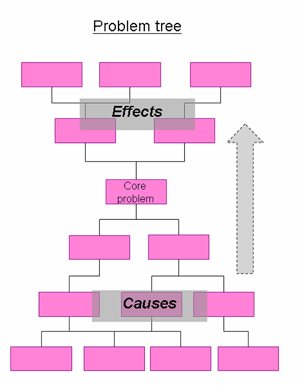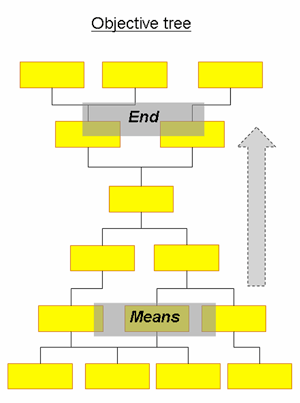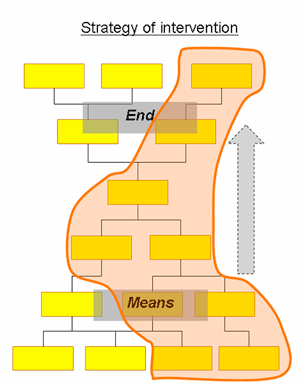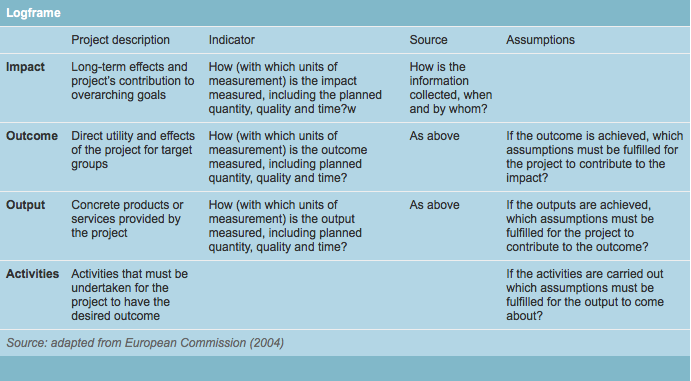The Logical Framework Approach (LFA) was developed for USAID in the 1960s. Since then it has been adopted and adapted by many other international development organisations. Among them was the German agency GTZ, which derived its Goal-Oriented Project Planning (ZOPP) from it. LFA is widely used today, although the methodology is often used in a more flexible and more pragmatic manner than in the 1970s and 1980s. Also, many approaches known as “Results-Based Management” (RBM) and “Managing for Development Results” are based on the Logical Framework Approach or are at least closely related to it.
The Logical Framework Approach is a systematic and analytical planning process used for the results-based planning of a project (or programme) and for the associated monitoring and evaluation system. The basic idea of the Logical Framework Approach is to condense the planned project mechanism down into a relatively simple, linear Logic Model, using a documented situation and problem analysis as the point of departure. This forms the basis for planning the monitoring and evaluation system, whereby the project’s outputs and effects are recorded by means of quantitative or qualitative indicators. Lastly, the project mechanism and the monitoring and evaluation system are summarised in a standardised table (logframe). The Logical Framework Approach is therefore not per se a method of measuring impact. Instead, it helps with planning projects and evaluating them in a goal- and results-based manner.
| Important The term Logical Framework Approach (LFA) should not be confused with the term Logical Framework Matrix (LFM), the so-called “logframe”. The Logical Framework Approach is the whole planning process, whereas the logframe is its product and one of its tools. |
Planning process
Descriptions of the precise approach vary slightly depending on the source. According to the European Commission’s PCM Guidelines, the Logical Framework Approach includes the following steps:
- Stakeholder analysis
The stakeholder analysis aims to clarify who the stakeholders (partners, target groups, beneficiaries, opponents, etc.) are that participate in the project and/or are positively or negatively affected by it. - Problem analysis
The problem analysis identifies the negative aspects of the existing situation. These are organised into causal links and presented in the form of a “problem tree”. Preferably, the problem tree should be drawn up in a participatory exercise with stakeholders.

- Objective analysis
During the objective analysis, solutions are drawn up for the problems that have been identified. The negative aspects shown in the problem tree are converted into desirable, positive future situations and presented as an objective tree according to a logic of means and end. In the simplest scenario, the objective tree is structured identically to the problem tree.

- Strategy analysis
The strategy analysis serves to clarify which (of usually several) ways to the objective in the objective tree is the most appropriate and feasible. Some of the criteria that need to be considered in doing this are: existing possibilities, probability of success, local ownership, cost, resources, relevance, effectiveness, negative effects, etc.

- Developing the Logical Framework Matrix
The results of the Logical Framework Analysis (stakeholders, problems, objectives, strategies) are presented in the Logical Framework Matrix (logframe). This provides a summary of the project design. The simplest form of logframe is a matrix with four columns and rows.

The first column of the logframe summarises what the project is supposed to do and shows the causal relation within the hierarchy of objectives. It is based on a linear Logic Model that runs from bottom to top. The fourth column contains the so-called assumptions. These are external factors that can potentially or definitely influence the success of the project, but lie outside the project managers’ sphere of influence. Together, the first and the fourth columns form the “vertical logic” of the logframe:
- If the activities are carried out and the assumptions (at this level) are correct, then the outputs are produced.
- If the outputs are produced and the assumptions are correct, then the outcomes are achieved.
- If the outcomes are achieved and the assumptions are correct, then the project will be able to contribute to the overarching goal (impact).
The second column is filled in with the indicators by which the achievement of objectives at the respective level can be measured. At the same time, how and where these indicators are to be collected (known as sources or means of verification) is entered into the third column. The relation between objectives, indicators and sources is called the “horizontal logic” of the logframe.
Suitability
The Logical Framework Approach is without any doubt a powerful tool for results-based project planning. The process is also oriented towards measuring the effects, although no means of measuring are explicitly mentioned. If the Logical Framework Approach is well implemented, it can:
- Promote dialogue between all parties;
- Contribute to identifying problems and correct solutions to them;
- Contribute to clarifying and expressing in concrete terms the project’s objectives and effects;
- Enable and plan evaluation and impact assessment.
Critics of the Logical Framework Approach note that the underlying logic model is too simple for the complex realities encountered in the field. They add that the Logical Framework Approach encourages tunnel vision and allows little flexibility. In practice, logframes (i.e. the matrix) are often filled out without going through the whole planning process. If that is the case, then it is indeed very simplistic. The Logical Framework Approach is occasionally criticised for being based on an exclusively Western mode of thinking and therefore not very suited to certain cultures.
Links
A shorter introduction to the Logical Framework Approach can be found here:
And much more information can be found on Rick Davies’ website:
More comprehensive manuals on the Logical Framework Approach can be found, for example, here:

